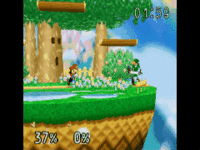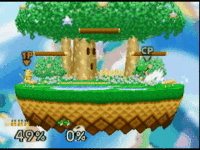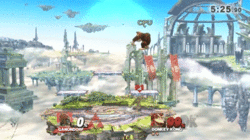Flaws in artificial intelligence: Difference between revisions
Tag: Mobile edit |
Melee Weegie (talk | contribs) Tag: Mobile edit |
||
| Line 30: | Line 30: | ||
[[File:FoxSelfDestructing.gif|250px|thumb|One of the most notorious AI flaws in ''Melee'', where level nine Fox will [https://www.youtube.com/watch?v=i-b3tCc3sn0 repeatedly self-destruct] on [[Jungle Japes]].]] | [[File:FoxSelfDestructing.gif|250px|thumb|One of the most notorious AI flaws in ''Melee'', where level nine Fox will [https://www.youtube.com/watch?v=i-b3tCc3sn0 repeatedly self-destruct] on [[Jungle Japes]].]] | ||
The AI in ''Super Smash Bros. Melee'' is also | The AI in ''Super Smash Bros. Melee'' is also infamous for how flawed it is. CPUs now have an even poorer [[approach]], always [[walk]]ing towards the player while periodically using projectiles, then [[spam]]ming their [[dash grab]] and jabs at close range, rarely using tilts or smashes outside specific situations. Unlike in ''SSB'', CPUs never [[dash]] at all other than for using dash grabs and [[dash attack]]s, and perform them instantly during the first frames of the initial dash, thus barely moving forward at all. They additionally never charge smash attacks (the {{SSBM|Ice Climbers}}' forward smash being the sole exception), and still won't attempt to attack grounded foes with aerials. CPUs also have a tendency to overuse other moves of specific characters, such as {{SSBM|Ganondorf}}'s [[Dark Dive]], {{SSBM|Zelda}}'s [[down tilt]], {{SSBM|Yoshi}}'s [[Egg Lay]] and {{SSBM|Mr. Game & Watch}}'s dash attack. Some characters are programmed to have bad follow-ups: {{SSBM|Captain Falcon}} for example will always use a down-throw followed by a [[Raptor Boost]] which rarely hits (depending on the character, percentage, and DI) and result in a self-destruct when done near the ledge. The overuse of jabs and grabs causes CPUs in ''Melee'' to generally have poor KOing abilities, as these moves are significantly weak in comparison to the smash attacks CPUs often used in ''SSB''. | ||
AI players still have a notably lackluster recovery: while they won't give up on recoveries as they did in ''SSB'', they still recover in a basic and predictable pattern with only their up special (or only side special with {{SSBM|Luigi}}), never using alternate methods like [[side special]]s or [[wall-grapple]]s, which causes them to fail many recoveries that were possible while making no effort at all to fight off edgeguarders. This results in CPUs being extremely easy to edgeguard, which is exacerbated by ''Melee''{{'}}s edgeguarding friendly physics. While they do possess precise [[meteor cancel]] abilities at even level 1, they are very easily beaten by other edgeguarding techniques, such as [[Wall of Pain|walls of pain]] or [[spike]]s. | AI players still have a notably lackluster recovery: while they won't give up on recoveries as they did in ''SSB'', they still recover in a basic and predictable pattern with only their up special (or only side special with {{SSBM|Luigi}}), never using alternate methods like [[side special]]s or [[wall-grapple]]s, which causes them to fail many recoveries that were possible while making no effort at all to fight off edgeguarders. This results in CPUs being extremely easy to edgeguard, which is exacerbated by ''Melee''{{'}}s edgeguarding friendly physics. While they do possess precise [[meteor cancel]] abilities at even level 1, they are very easily beaten by other edgeguarding techniques, such as [[Wall of Pain|walls of pain]] or [[spike]]s. | ||
Revision as of 22:17, May 5, 2020
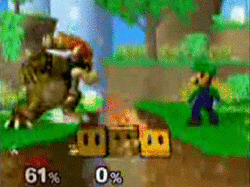
While it is notable that the high level artificial intelligence is precise with its reflexes, such as being able to perfect shield almost any attack, reflect projectiles with little hesitation, counterattack out of knockback the instant it can act, and land or control attacks that human players would find difficult such as Pikachu's Volt Tackle and Ryu's special moves with his Street Fighter inputs, all five games are known for having CPUs that can be extremely flawed even when set to the highest level setting. CPUs also never use techniques that are complex or otherwise require specific timing, such as dash dancing, chaingrabbing and edge hopping, nor use other such advanced techniques like L-canceling, wave dashing and DACUSing, which are crucial for achieving strong results in competitive play, in addition to never changing their playstyle, preventing players from adapting to different battle tactics. In all Smash games, CPUs also ignore when team attack is turned on in Team Battles, causing them to inadvertently use powerful attacks near teammates at high damage and KO them, making CPUs impractical for Team Battles with tournament settings.
There are many complaints surrounding the poor artificial intelligence of computer players in Super Smash Bros. and Super Smash Bros. Melee, though Super Smash Bros. Brawl and Super Smash Bros. 4 have also received attention to their flawed AI system; in all five games, particularly noteworthy and amusing AI flaws have been uploaded to YouTube, often with the caption that the "AI is just too good".
Flaws in artificial intelligence essentially refers to poor behaviors of computer players (CPUs), such as making very predictable approach options and spamming moves like projectiles and approach attacks (such as Spin Dash) even if this can prove to be unsafe, as well as having poor recoveries and not properly recognizing stage hazards. SSB and Melee notoriously have the most flawed AI in the series: in the latter game, CPUs always approach by walking to the foe, periodically using projectiles, then spamming neutral attacks and grabs in close, while almost never shielding or dodging attacks, and as well having poor recoveries involving use of only their up special (except for Luigi, who only uses Green Missile for recovery regardless of circumstances). Brawl would then improve the AI in many ways, such as by making it more prominently shield and dodge attacks, choose better recovery options, and generally understand attacks better without overusing a specific one: these enhancements would then carry over to Smash 4. Despite this, the latter games still have many other significant flaws in their AI.
Super Smash Bros.
As many players might expect from the first Super Smash Bros. game, the AI is considered poor even with CPUs set to level nine. When fighting, their main method of attack is to constantly use their neutral specials (with only a few exceptions), especially projectiles such as Mario's Fireballs, alongside smash attacks. Other than using tilts occasionally, they tend to not use other attacks, using neutral attacks and grabs rarely, though high-leveled CPUs do combine these two for a jab grab.
While CPUs in SSB chase foes in midair with aerial attacks more often than in subsequent games, they will never use them to attack foes standing on the ground, rarely short hopping on the whole. Specific CPUs also tend to overuse one type of aerial attack, no matter their opponents' position, such as Fox heavily spamming his up aerial against airborne enemies to juggle them, and Samus repeatedly using her down aerial. However, CPUs still have perfect precision with aerial attacks, using them as soon as they are in range with the foe, which gives them an exceptional combo potential considering the high hitstun in SSB.
The AI also has a significantly poor recovery as it never attempts to use its up special again after being attacked out of it, and always recovers by moving towards the stage while not avoiding or throwing out any attacks against edge guarders. Their defensive abilities are flawed in a similar way: they often hold their shield against consecutive-hitting moves such as Kirby's jab even if they can escape them, breaking their shields instead, and overuse rolls to dodge attacks even after the player stops attacking, allowing easy punishes with attacks like down smashes. Outside of this, however, grounded CPUs are still generally able to defend in time against attacks, using their shields more often than in Melee, as well as being able to tech successfully in some occasions. CPUs additionally don't properly recognize reflecting and absorbing moves, despite themselves precisely using these moves against oncoming projectiles, allowing the player to potentially heal critical damage or take stocks out of them if a strong projectile is absorbed/reflected.
CPUs in SSB are also well known for their tendency to use items excessively. Regardless of the CPU level and item, when an item appears, CPUs will completely ignore foes and go for the item, often putting themselves in harm's way while doing so, especially because of the incapability to grab items in midair in SSB. They also fail to recognize certain items when they are active, often walking into their own Bumpers or Motion-Sensor Bombs, resulting in self-destructs. They similarly have poor understandings of numerous stages, persistently running into walls and walking into hazards such as the tornadoes on Hyrule Castle.
It is a common misconception among Smashers who have not played SSB that the AI in this game is better at KOing than in the later Smash games. However, this is just because of the CPUs' higher tendency to use smash attacks than in the subsequent games, such as Donkey Kong and Captain Falcon frequently using their down smashes, as well as their perfect precision with aerial attacks that allows for unexpected combos, plus their ability to easily use techniques such as jab grab; compared to other Smash games, players find it difficult to avoid these instances due to the high hitstun in the game and the lack of directional influence. This, exacerbated by SSB's powerful aerials and the incapability of air dodging, along with the much more powerful throws in the game, tends to cause speculations that the AI in this game is better at comboing and KOing, and therefore it is more powerful than in the other games.
This is arguably not true, however, as CPUs in this game have poor understandings of numerous attacks, as well as exhibiting strange behaviors in complex situations, poor defensive play that involves spamming rolls and not attempting to get away from attacks when airborne, and an easily gimpable recovery that allows them to be easily KO'd. These flaws, therefore, make even level nine CPUs easily beatable by any experienced players as well as intermediate gamers and even casual ones if they are able to exploit their flaws effectively.
Because of these numerous flaws, the AI in SSB is often considered, along with that of Melee, to be the worst in the entire Smash series.
Super Smash Bros. Melee
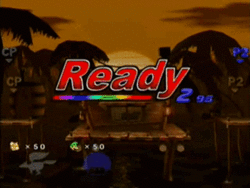
The AI in Super Smash Bros. Melee is also infamous for how flawed it is. CPUs now have an even poorer approach, always walking towards the player while periodically using projectiles, then spamming their dash grab and jabs at close range, rarely using tilts or smashes outside specific situations. Unlike in SSB, CPUs never dash at all other than for using dash grabs and dash attacks, and perform them instantly during the first frames of the initial dash, thus barely moving forward at all. They additionally never charge smash attacks (the Ice Climbers' forward smash being the sole exception), and still won't attempt to attack grounded foes with aerials. CPUs also have a tendency to overuse other moves of specific characters, such as Ganondorf's Dark Dive, Zelda's down tilt, Yoshi's Egg Lay and Mr. Game & Watch's dash attack. Some characters are programmed to have bad follow-ups: Captain Falcon for example will always use a down-throw followed by a Raptor Boost which rarely hits (depending on the character, percentage, and DI) and result in a self-destruct when done near the ledge. The overuse of jabs and grabs causes CPUs in Melee to generally have poor KOing abilities, as these moves are significantly weak in comparison to the smash attacks CPUs often used in SSB.
AI players still have a notably lackluster recovery: while they won't give up on recoveries as they did in SSB, they still recover in a basic and predictable pattern with only their up special (or only side special with Luigi), never using alternate methods like side specials or wall-grapples, which causes them to fail many recoveries that were possible while making no effort at all to fight off edgeguarders. This results in CPUs being extremely easy to edgeguard, which is exacerbated by Melee's edgeguarding friendly physics. While they do possess precise meteor cancel abilities at even level 1, they are very easily beaten by other edgeguarding techniques, such as walls of pain or spikes.
The AI in Melee also makes poor use of shields and defensive maneuvers in general, even worse than in SSB: it will almost never shield or dodge attacks even at level 9 (never sidestepping intentionally to dodge at all), taking whatever attack is thrown their way, which when combined with their constant approaching, often leads to them just walking into a player's charged attack, or even a slow and punishable but powerful attack like a Falcon Punch. The AI will only sidestep if it is on a soft platform and wants to both fall through the platform and shield an oncoming projectile at the same time (the AI only seems to do this for projectiles and not direct attacks). On the other hand, though, high leveled CPUs are very precise with powershielding, usually succeeding with it when they do shield attacks, and while they rarely shield physical moves, they will reflect almost any oncoming projectile with their powershields when not in lag. They are also programmed to always dodge specific attacks, examples being: Bowser Bomb, Bowser's up smash, Yoshi Bomb, Dancing Blade and the uppercut of Raptor Boost. They still do this to a fault, however, as in the former case, CPUs will prioritize reflecting projectiles over anything else and stand in place shielding even if that causes them to break their shield, and in the latter case, they often make basic dodging choices with their rolls or air dodges, sometimes even rolling towards edges or air dodging straight into the attack, getting hit anyway.
Being ironically the opposite of the AI in SSB, the AI in Melee never uses items intentionally, only picking them up accidentally when attacking foes with jabs near them: it will only go for healing items, Cloaking Devices, Hammers and Poké Balls, and even then, CPUs cease all fighting and flee to pick up these items, which is notable on large stages. They ignore any changes made to their physique and play as if they were normal, which leads to instances where they often will self destruct simply by trying to move, such as giant CPUs inadvertently walking off stages, and metal CPUs quickly plummeting to their death as they attack an offstage player. They additionally always walk into set Motion-Sensor Bombs, walking Bob-ombs, and hostile Poké Ball Pokémon, which often results in an otherwise avoidable SD for them. Furthermore, CPUs have poor navigation of many stages, carelessly attacking foes near pits and falling into them, especially in Jungle Japes, and having difficulty traversing platforms like the clouds in Yoshi's Island 64 or going up in Icicle Mountain to escape the lower blast line when the stage speeds up.
Super Smash Bros. Brawl
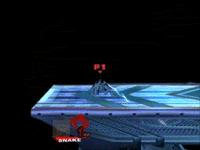
Given how lackluster the AI was considered in both Super Smash Bros. and Super Smash Bros. Melee even at level nine, the AI was almost completely overhauled in Super Smash Bros. Brawl, becoming significantly more proficient in many areas. CPUs will now properly shield and dodge dangerous attacks thrown at them, with level 9 CPUs perfect shielding, rolling, sidestepping, or air dodging almost any attack with one-frame reactions. CPUs can now properly charge up or hold smash attacks and special attacks, among others, and choose more alternatives when using certain attacks, such as Kirby spitting out characters more often, Link using his grab aerial and the second hit of his forward smash, Marth using other variations of Dancing Blade, and Peach mostly auto floating to use aerials against grounded opponents. They have become much better at approaching, as they now use their full dashes to move and finally try to attack grounded foes with aerials, along with being generally more varied with their attack choices at close range, integrating tilts and smash attacks.
The AI is notably more efficient with its recoveries, using any side specials or tether recoveries their character has to aid them, and will as well punish opponents more often, always shield grabbing them when optimal, instead of just rolling or dropping their shield after being attacked. It is also much better at handling items in comparison to previous games, as it now recognizes and uses all items that appear, while also repelling any other players trying to get them, and not ceasing fighting if an item appears too far from them (exempting the Smash Ball) unless the foe goes for it. When a dangerous item or attack such as a Hammer or Final Smash is active on the field, CPUs on revival platforms will stay on them instead of reentering the fight instantly, and also attack any other stragglers while staying away from it.
The significant improvements on Brawl's AI caused many speculations to arise during the game's early years, with many videos being uploaded to YouTube claiming that the AI was "impossible to beat", in conjunction with rumors being spread around the Smash community that the AI supposedly "read" human inputs to defend against attacks, or could even "learn" from human players. These rumors were later proven false.
The flaws in Brawl's AI are considerably lesser and less recurrent than in Melee, but can still be potent. CPUs still tend to be easier to KO and edgeguard than the average human player, even when set to level 9, due to not utilizing survival techniques such as DI and usually not fighting back when being edge-guarded. While they do air dodge when sent flying, this minimal knockback cushioning is usually not enough to save them. CPUs tend to have difficulty avoiding certain stage hazards (most notably on Mario Bros.), and are prone to self-destructing in scrolling stages such as Rainbow Cruise and Big Blue.
While CPUs are better at recovering than in previous games, they still underutilize recoveries, such as by not making use of alternate recovery options with some characters (such as Lucas), or always recovering in the same direction with a recovery move. A computer player, regardless of level, will also always aim for solid platforms that can be sweetspotted when recovering, even when there are "soft" platforms off the stage. They also tend to play strangely in complex custom stages and in overly large and complex stages like New Pork City and 75m, where they might stand in a place attacking nothing, or unintentionally self-destruct while navigating platforms and hazards. Despite recognizing items and using them better than in the previous installments, they may still self-destruct with certain items, such as by walking into a row of Bob-ombs when approaching a player, self-destructing with their own explosives, or inadvertently attacking a Blast Box and being KO'd by it.
Aside from being flawed as stated above, in free-for-alls, CPUs will all target the human player even if they aren't teamed. They will also target the character that has the highest damage to earn a KO, and in doing so will not attack other CPUs, which results in the CPUs following each other in lockstep. This mechanic has been severely hated by many fans to where FFAs are considered to actually be a 1-vs-3 (player vs. computers).
The AI now has a bigger taunting window, not limited to the exact moment they KO someone. Teammates may also taunt with them.
Super Smash Bros. 4
In early Super Smash Bros. for Nintendo 3DS
In the first versions of Super Smash Bros. for Nintendo 3DS, the AI remains mostly the same from Brawl, retaining most of the improvements made to it from Melee. One change is that CPUs are more prone to attacking foes after shielding or dodging attacks, especially with grabs and forward smashes, and CPU characters with counterattack special moves use them more prominently against any strong attacks when not in lag, being very precise with them. The AI in Smash 3DS is also slightly better at edgeguarding, as characters without projectiles now edgeguard offstage more often (though those with projectiles will still usually attack from the edge, spamming them) by jumping a fair distance away from the edge and intercepting with an aerial or special attack (preferably those that meteor smash), while very rarely self-destructing like they did in previous games. CPUs in free-for-alls no longer follow human players only, now targeting other CPUs and fighting against each other if a human player is out of range, like in SSB and Melee, though they still preferably target players with high damage percentages to earn KOs as soon as possible.
The AI also retains most of its improved behaviors with items from Brawl, and makes better use of them than in said game: it seems to be more aware of opposing items, normally staying away from areas where a powerful item covering a wide range (such as a Snorlax or Hocotate Bomb) is about to come down, and avoiding walking directly into set Motion-Sensor Bombs, Pitfalls or hostile Pokémon, a flaw that they commonly exhibited in Brawl. Additionally, CPUs now shield and dodge potentially dangerous items thrown at them more often (though they still throw explosives at themselves or too close to enemies).
The AI in Smash 3DS has also gained some other flaws, however, which are unfortunately more potent than in Brawl. When at long distances from foes, CPUs spam projectiles nearly as much as in Melee, even if these can be easily reflected or absorbed (though unlike in the previous games, they will stop using them when they spot a player with an active reflector/absorber): these include regular attacks that serve as projectiles, such as Mega Man's Mega Buster attacks and the Villager's forward air. Certain characters also overuse other special moves (generally long-ranged approaching ones), even those they didn't before, such as Falcon Kick, Rollout and Wario Bike, and CPUs with counterattack moves also abuse them to the point they end up spamming them as well.
CPUs also have poorer defensive abilities than in Brawl, as they sometimes hold their shield against attacks until it's close to breaking, and overuse rolls to stay safe from attacks, eventually making them punishable. After shielding or rolling, CPUs will nearly always attack foes at close range with a grab or forward smash, causing them to become predictable, avoidable and punishable. They seem to ignore the landing lag from air dodges, becoming vulnerable when air dodging close to the ground. Moreover, CPUs still won't attempt to evade or fight off edgeguarders, causing them to be easily KO'd, under-utilize some characters' recoveries, and still exhibits most of their flaws from Brawl on certain stages.
In general, despite some of the improvements made to it, the AI in early Smash 3DS plays generally poorer than in Brawl, being notably easier to predict and KO, as well as having poorer defensive abilities; thus, it is much less efficient. The AI was later changed in subsequent versions of the game and the Wii U version, though (more information can be seen below).
In Super Smash Bros. for Wii U and patches
In Super Smash Bros. for Wii U, the AI has had most of its flaws from Smash 3DS addressed and fixed: CPUs will no longer overuse their forward smashes, attempt to use worn-out projectiles (such as Robin's Thunder with the Tome worn out), hold their shields for a long time or air dodge almost all the time when launched. Another prominent change is that CPUs now finally attempt to avoid edgeguarders during their recovery, air dodging any oncoming attacks while carrying on their recovery afterward; they will also always footstool foes coming near when they have the opportunity, a behavior exhibited even by Mii Fighters in Multi-Man modes, including Cruel Smash.
CPUs are more proficient using short-hopped aerial attacks, and will now always use out of shield up smashes when possible, improving their defensive game. They also choose better follow-up options when using certain attacks, more often following up their jabs with other moves (such as CPU Fox following up his second jab with a grab, as well as Captain Falcon with Falcon Dive), and finally, take the advantage to unleash a fully charged smash attack on a foe stunned from a broken shield. They also notoriously combo their throws into aerials more often, with most CPU characters at high levels being programmed to always follow up their down throw with a specific aerial or special move, examples being Luigi into his forward air or Luigi Cyclone, or Meta Knight into Shuttle Loop.
For the first time in the Super Smash Bros. series, CPUs in Smash U partaking in Team Battles will automatically and immediately use any remaining stocks that other teammates have (as long as they are all CPUs as well), regardless of their level, increasing their chances of success.
Despite all these improvements being made to the AI, though, it still possesses some flaws. CPUs still use projectiles more frequently than regular attacks when at far distances (allowing characters with chargeable special moves to freely charge against other characters with projectiles), and characters like Wario and Captain Falcon still tend to spam certain other special moves. They still seem to ignore character differences when doing certain actions; they may still roll often with characters like Yoshi and Samus (whose rolls are slow and easily punishable), use out of shield up smashes with those whose up smash is either slow (such as Ike) or has poor horizontal range (such as Mega Man), or favor their back throw or down throw as a KO throw and combo throw respectively, even if those throws are not the optimal choice in those situations (such as with Bowser, who will not attempt any follow-up even if it does choose to use up throw). They are also prone to overdoing their throw combos (such as with Meta Knight, who will continue to attempt Shuttle Loop after down throw even at high percentages where it no longer works), as well as misspacing their attacks, either getting consistently shield-grabbed or whiff punished by potentially fatal attacks.
CPUs additionally do not change their "playstyle" in free-for-alls, causing them to use grabs or projectiles that can only hit one foe at a time, instead of more frequently using others that can hit multiple foes, giving them several problems, especially in 8-Player Smash battles. Aside from this, CPUs still behave rather eccentrically in complex or custom stages, where they can have difficulty recognizing walls and hazards or jumping across platforms, as well as aiming recoveries.
Additionally, while CPUs will now always evade edgeguarders when possible, they still do this to a fault, as they air dodge attacks even when falling down and away from the ledge or platform they're aiming, which, when attacked repeatedly, can make them miss it completely (a problem especially for characters with poor vertical recoveries, such as Donkey Kong and Little Mac), failing a recovery that was possible and getting KO'd.
However, with Super Smash Bros. 4's ability to be updated, some acknowledged AI flaws have been fixed: in current versions, for example, CPUs are less prone to self-destructing when dodging edgeguarders, and use pummels and KO throws more often when grabbing foes at high percentages. Particularly, patch 1.0.5 of Smash 3DS updated the AI implementing all of its upgrades in Smash Wii U. Due to the overall great improvements made to it over previous games, the current AI in Smash 4 is considered to be one of the best of all the Super Smash Bros. series.
Super Smash Bros. Ultimate
As with all previous games, the AI has been improved dramatically from the transition to Super Smash Bros. Ultimate. While many changes were ported from Super Smash Bros. for Wii U, some new changes have addressed their previous issues alongside the addition of new improvements, though flaws in their programming are still apparent.
One of the most drastic improvements involve their efficiency: CPUs now perform far better even at lower difficulty levels, with added aggression and reaction times even at as low as level 5. Guaranteed teching is now common throughout difficulty levels due to the extended frame window for teching, and higher-leveled CPUs will actively edgeguard even while being edgeguarded themselves. This makes attacking recovering Level 9s an extremely risky endeavor, as they will always tech stage spikes and retaliate with frame perfect stage spikes of their own, often in a row. They will also always attempt to hit offstage opponents instead of waiting on-stage, and will even use aerials to cover themselves while recovering, reducing their own vulnerability to edgeguarding. In contrast to the previous games, CPUs will even act in anticipation of attacks at higher levels, compared to the reaction-based responses of previous CPUs; this includes shielding or spotdodging early to dodge potential attacks. As a result, CPU players are less predictable and harder to fend off in general, especially in conjunction with their fast response times.
CPUs have also been programmed to take advantage of the new game mechanics. Despite the changes to the perfect shield mechanic, CPUs still have no trouble performing them, as they will now perfectly release their shield upon receiving an attack. CPUs will also perform the re-added directional air dodge mechanic to extend the invincibility time gained when recovering to a ledge, especially if attacked near one. Characters with new abilities, such as Link with his Remote Bomb Rune, now have new attack patterns associated with them as well, and some CPUs playing fighters with character-specific advantages will now actively take advantage of them (for example, Snake using his C4 to extend his recovery).
For the first time in the series, CPUs will perform advanced techniques at higher difficulty levels. CPUs using fighters with excellent dash dances (such as Little Mac) will begin performing them as an approach option, while those with powerful aerial combo abilities will begin throwing out short-hop aerials at high speeds to pressure shields and initiate combos (such as Pichu, Ryu and Ken). B-reverses and reverse aerial rushes also become fairly common. At Level 9, these habits will become extremely frequent and often becomes the main tactic they do against human players. They will even space attacks against shield to prevent punishment through a shield grab.
The effectiveness of CPU players was enough to gain slight notoriety within the community and Nintendo themselves, with the official 1.2.0 patch reducing the difficulty of CPUs in "Challenger Approaching" matches to make unlocking new fighters easier.
In spite of all the improvements made to the AI, CPU-controlled players are still flawed in many ways. Some of these problems return from Smash 4 despite their frequency: several CPUs still retain their inability to recover, such as Little Mac (CPUs will never use his now-buffed Jolt Haymaker to extend his recovery alongside Rising Uppercut) and Bayonetta (CPUs still fail to use After Burner Kick after a Witch Twist, therefore dying extremely early). CPUs controlling fighters with projectiles will still only use them at a certain distance most of the time, most notoriously with Cloud, who will still launch a Blade Beam at far enough distances even if it means expending a charged Limit Gauge. Those with specific KO throws will still depend on their back throw to KO at high percentages, regardless of positioning or effectiveness of the throw compared to others, and CPUs will still pummel extremely slowly despite the increase to pummel speeds. As with previous games, higher-leveled CPUs can also be baited to use laggy moves or dodges to put them in an instant disadvantage, such as shielding to force a CPU Incineroar to attempt an Alolan Whip, or using a quick aerial to make them waste their air dodge, which can no longer be spammed in Ultimate. CPU's also still lack the ability to properly anticipiate and dodge dangerous, slow attacks - allowing them to be KO'ed extremely early by moves such as Piranha Plant's up smash or Ptooie.
Despite their new edgeguarding strengths, CPU players now act inclined to do so: if only high-level CPUs are in play, all of them will eventually flock towards an edge to edgeguard one CPU, which causes a long loop of fighters attempting to edgeguard each other. This occurs even if the CPU has no reason to edgeguard in the first place; for example, if they have a very exploitable or weak recovery, or while fighting another nearby CPU (in fact, both CPUs would slowly move towards the edge to edgeguard an offstage opponent).
Much like in previous games, higher-leveled CPU players will always attempt to target human players first instead of other CPU players, even if they are closer; this commonly turns single-player Free-For-Alls into frame-perfect combo sessions with the human player being the sole target, even if CPUs are standing right next to each other. Conversely, CPUs will not have the same quick reaction times if pit against other CPUs, with the exception of while edgeguarding, and will spread out their targets.
Finally, some new problems now exist, including CPU-controlled Chroms walking offstage for seemingly no reason only to be unable to recover and plummet to their death with Soaring Slash, CPU-controlled Jokers using Wings of Rebellion while onstage, CPUs breaking Fake Smash Balls instead of trying to dodge them entirely or CPUs freezing on the spot after KOing a human player during a 1v1 match, performing frame-perfect dash dances until approached. In addition, CPUs will also likely respond incorrectly to certain attacks, items, and stage hazards that they were able to respond correctly to in previous games, such as the Don't Move! and Taunt! Microgames from the WarioWare, Inc. stage.
It should be noted that Spirit Battles utilize numerous, specialized CPU settings, which can cause CPUs' effectiveness in the mode to vary wildly.
Regardless, due to the drastic improvements made to CPUs, the current AI in Smash Ultimate is considered to be the best of all the Super Smash Bros. games, due to their numerous changes making them much smarter than before.
